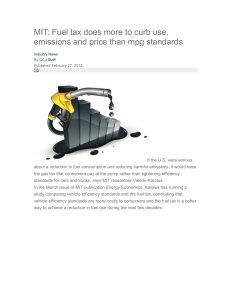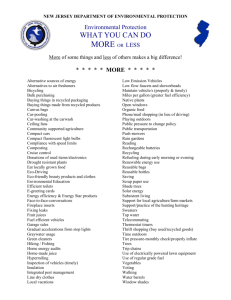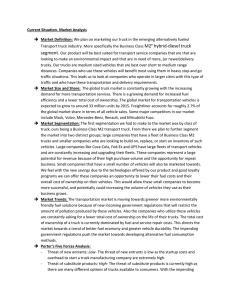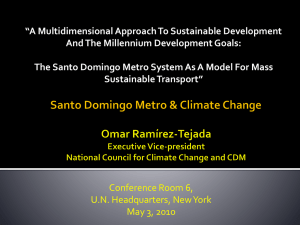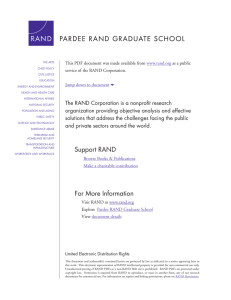Rolling Out the Next Generation of Advanced Vehicles
advertisement
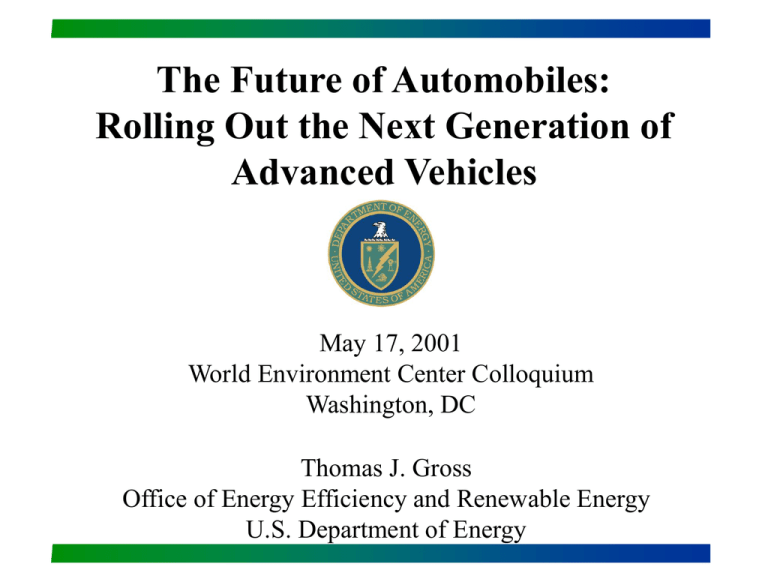
The Future of Automobiles: Rolling Out the Next Generation of Advanced Vehicles May 17, 2001 World Environment Center Colloquium Washington, DC Thomas J. Gross Office of Energy Efficiency and Renewable Energy U.S. Department of Energy U.S. Transportation Uses More Oil Than Is Produced Domestically Highway Carbon Emissions (million metric tons) 14 12 Domestic Oil Production 1990 2000 325 384 2010 455 2020 507 Heavy Trucks 10 8 Light Trucks 6 4 2 Automobiles 0 1970 1980 1990 2000 Actual 2010 2020 Projected Source: Transportation Energy Data Book: Edition 19, DOE/ORNL-6958, September 1999, and EIA Annual Energy Outlook 2000, DOE/EIA0383(2000), December 1999 2 Closing the Oil Gap Increase the Supply of Oil AND Reduce the Demand for Oil • Improve the Fuel Economy of Vehicles • • (& other Oil Using Equipment) Replace Oil with Alternative Fuels (& Feedstocks) Reduce the Amount of Travel (& other Behavioral Changes) 3 Partnerships Are Key to Success Bioenergy Initiative US AMP Government-Industry 21st Century Truck Partnership USABC 4 PNGV: A Historic Collaboration Between Industry & Government PARTNERSHIP FOR A NEW GENERATION OF VEHICLES Daimler Chrysler Suppliers Universities Small Business Federal Labs Ford GM Capabilities Prioritized Needs USCAR Resources Technologies Technologies Government Industry Partnership (PNGV) Goal 1: Adv. Manufacturing DO C DOE Technologies Resources DOT NSF Government Agencies (DOC Lead) DOD EPA NASA Goal 2: Near-Term Vehicle Improvements Goal 3: Triple Fuel Efficiency (up to 80 mpg) 5 PNGV Technology Milestones Completed on Schedule PARTNERSHIP FOR A NEW GENERATION OF VEHICLES 1993 • Hybrid Vehicles • Fuel Cells, Fuel Reformers • CIDI Engines, Turbines • • Low Emissions Technologies New Materials • Advanced Design Simulations • Efficient Electronics and Electrical Devices • Advanced Batteries Ultra-Capacitors and Flywheels • Focus and Accelerate Candidates for Development: Technology Selection Decisions Completed 1997 2000 Three Concept Cars 2004 Three Production Prototype Cars Technology Concept Vehicles 6 Technology Portfolio Continues to Evolve PARTNERSHIP FOR A NEW GENERATION OF VEHICLES Engine/Power Sources • Advanced Heat Engines – DI Engines – HCCI – VCR • Combustion and Aftertreatment – Lean NOx Catalyst – EGR – Traps • Fuel Cell • Batteries – NiMH Battery – Lithium Battery • Pneumatic/Hydraulic Storage • Power Electronics – Invertors/Controllers – Motors – Ultracapacitors – Electric Systems Development • Aerodynamics • Rolling Resistance – Tires • Accessory Loads – HVAC • Powertrain Configuration – Parallel HEV – Series HEV Most promising options Other technologies Fuels Utilization • Gasoline • Diesel Fuels and Blends (<30 ppm sulfur) • Natural Gas • Methanol • Fischer-Tropsch • Dimethyl Ether • Ethanol • Hydrogen Advanced Materials • Lightweight Materials – Aluminum/Composite BIW – Composite BIW • Propulsion Materials 7 2000 PNGV Concept Vehicles PARTNERSHIP FOR A NEW GENERATION OF VEHICLES Ford Prodigy GM Precept • Lightweight materials reduce DaimlerChrysler ESX3 vehicle body structure weight 50%* • Integrated starter/alternator* • 33% reduction in aerodynamic drag • Advanced diesel engine with 35% efficiency improvement projected to exceed 70 mpg (gasoline equivalent)* • Body system weighs 46% less* • High-power battery * • Efficient diesel engine, motor, and battery projected at 72 mpg (gasoline equivalent)* • Cost penalty halved to $7500 • • • • Vehicle body weight reduced 45% * World’s most energy efficient vehicle lighting system Lowest drag coefficient ever recorded for a 5-p sedan Dual-axle parallel hybrid achieves 79.6 mpg (gasoline equivalent) *Government supported technologies 8 Many Research Facilities and Firms Are Working to Make PNGV a Success 19 2 2 5 17 8 1 1 6 22 79 10 34 35 21 53 89 26 343 36 10 13 124 1 82 30 65 2 15 1 15 9 7 51 2 4 1 3 4 10 RI 2 31 1 9 1 1,201 Projects at 622 Sites, including 51 Universities and 21 Federal Labs in 47 States 9 DOE Support of PNGV Is Focused on Long-Range, High-Risk R&D Research 2000 2004 2008 2012 Validation Integration Goal 3: 3X Research Production Concept Cars DOE Support of PNGV Productio n Prototype Vehicle Program s Government & Industry Industry Next Concept Productio n 10 Difficult, but Surmountable, Research Challenges Remain to Achieve Very High Fuel Economy Hybrid Systems: CIDI Engines: Parallel configuration offers best option to meet 80 mpg. Series configuration may be used with fuel cells. Cost, weight, and packaging remain as challenges. Mature technology with 44% efficiency, but Nox and particulate emissions remain challenges. Fuel Cells: Lowest onboard emissions and potential for highest efficiency, but cost, systems integration, and fueling infrastructure are major challenges. Energy Storage: Considerable progress in developing high-power battery; focus now on cost and cycle life. Power Electronics: Progress on cost, power-to-weight ratios, and efficiencies needed. Light Materials: Significant weight reductions achieved. Major issues are cost, manufacturability, joining, recycling, and repair. Fuels: Fuel impacts on infrastructure must be addressed. Thorough evaluation is needed of the effects of fuel composition and physical properties on CIDI and fuel systems’ performance. 11 Technology Is Migrating into New U.S. Vehicles • Hybrid-electric drives scheduled for: – – – – Dodge Durango in 2003 Ford Escape in 2003 Chevrolet Silverado in 2004 and Ford Explorer in 2005 • 412 pounds of lightweight aluminum in the 2000 Lincoln LS • Aluminum used for door, deck, and hood panels for Cadillac, Oldsmobile, and Chevrolet vehicles • 50-pounds lighter composite pickup truck box on the 2001 Chevrolet Silverado • Production of a new, lighter, recyclable thermoplastic hardtop for the Jeep Wrangler in 2001 12 21st Century Truck Partnership DOE/EE/OTT Heavy Vehicle Department of Technologies R&D Energy Department of Transportation Intelligent Vehicle and Highway Safety R&D S S ITED TATE UN E N NA GEN CY VI R ON M General Motors Honeywell International Truck and Engine Mack Trucks NovaBUS Oshkosh Truck PACCAR Volvo Trucks North America EN Allison Transmission BAE SYSTEMS Controls Caterpillar Cummins DaimlerChrysler Detroit Diesel Eaton Corporation Freightliner Department of Defense TA IO Industry Participants Army/TACOM NAC Military Vehicle R&D L P ROT EC T Environmental Protection Agency Vehicle Emissions Regulations 13 21st Century Truck Partnership Declaration of Intent Develop production prototype vehicles that: Improve fuel efficiency, specifically, by 2010; Double the Class 8 long-haul truck fuel efficiency*; Triple the Class 2b and 6 truck (delivery van) fuel efficiency*; and Triple the Class 8 transit bus fuel efficiency*; Exceed expected emissions standards for 2010; Meet or exceed motor carrier safety goal of reducing truck fatalities by half in ten years; and Enhance affordability, and maintain or enhance performance. * On a ton-mile per gallon basis 14 Many Federal Roles in Promoting Advanced Vehicles Area • • • • • Research & Development Demonstration Deployment Incentives & Funding Regulation Example • • • • • PNGV U.S. Postal Service Energy Policy Act TEA-21 Clean Air Act 15 Selected Transportation Policies Policy Year Regulations & Standards EPCA (CAFE) 1975 AMFA 1988 EPACT 1992 ISTEA & TEA-21 1991 & 1996 Financial Incentives Information 16 Selected Proposals to Promote Clean and Efficient Vehicles Types of Incentives/Inducements Bill S. 389 Murkowski AFVS EVs Hybrids Fuel Cells Fuel Use Stations HOV Lanes Federal Agencies S. 597 Bingaman S. 760 Hatch 17 Federal Agencies Can Have A Role • Number of vehicles in the Federal fleet – 578,000 • Number of alternative fuel vehicles – 55,000 • Estimated annual purchases – 55,000 Sedans ~ 17,500 Light trucks, vans, SUVs ~ 22,500 Medium, heavy-duty vehicles ~ 15,000 • Average cost for Federal vehicles is low Compact sedans @ $12,000; light trucks @ $13,000 • Fleets are located all over the country, including rural areas 18 Executive Order 13149 April 2000 Goals and Requirements: – 20% Petroleum Reduction in Covered Federal Fleets in FY 2005 Compared to FY 1999 Baseline – Use of Alternative Fuel in AFVs by FY 2005 – Increased Average Fuel Economy of New Light Duty Vehicle Acquisitions 19 In Summary Federal role – Energy supply and demand are national issues – Federal efforts can support industry marketing – Testing and evaluation; consumer education; Clean Cities – Federal agency demonstrations Comprehensive program – Multiple market segments (e.g., light and heavy duty) – Multiple technology options and fuels Coordination and partnership are critical Long term commitment is necessary 20

